Mr. Brabec says on his website that it does take time to make his bread, but it is well worth it. This recipe is for a rye bread. I have tried several different breads, but I have yet to try his. I am sure it will be just as delicious as his rohliky.
Below is the image of the ingredients used:
melasa = molasses, voda a koreni = water and spices, olej = oil, sul = salt, ocet = vinegar, hnedy cukr = brown sugar, drozdi = yeast, zitne krupky = coarse rye meal , psenicna a zitna mouka = wheat and rye flour
LEAVEN
Leaven is the most important ingredient and it takes long time to make it (6 days). However, if you chose to make your bread using your leaven, you can refrigerate your leaven for a long time. If you do not use all of your leaven immediately, add some flour and water and let "rise" until next time. If you want to speed up the baking you can use just yeast and to give the bread the "sour" taste you can use a little bit more of vinegar.
Ingredients:
1 liter (about a quart) sized container with wide opening and a lid
1 medium sized potato
1 cup light rye flour
1 teaspoon dry yeast
1 and 1/2 cups warm water
- Peal the potato and finely grate it (same size grater as you would use for grating nutmeg)
- Put it into the container
- Add flour, yeast and water and stir very well
- Keep stirring often
- Leave the leaven sit in room temperature for 24 hours - DO NOT CLOSE the lid - the "gas" needs to escape.
- The next day add 1/2 cup flour ad 1/2 cup water and stir very well
- Let it "rise" another day
- Repeat everything on the third day again and again keep stirring. If the leaven is too thick add a little water.
- After the forth day stir only occasionally. When you see brownish fluid it is a sign that the leaven is ready. You can use it to make your bread or put it into the refrigerator for future use.
DOUGH:
Ingredients:
3 cups all purpose wheat flour
2 and 1/2 cups light rye flour
1/2 cup coarse rye meal
2/3 cup leaven
3 teaspoons salt
2 Tablespoons molasses
1 Tablespoon brown sugar
3 Tablespoons caraway seeds
2 Tablespoons canola oil
2 Tablespoons vinegar (if you use a home made leaven then only 1 Tablespoon)
1 and 1/2 Tablespoons dry yeast (if you use a home made leaven then just 1/2 Tablespoon)
2 and 1/2 cups water
1/2 cup flour for use while working with the dough and to sprinkle it onto your baking sheet
2 Tablespoons canola oil
2 Tablespoons vinegar (if you use a home made leaven then only 1 Tablespoon)
1 and 1/2 Tablespoons dry yeast (if you use a home made leaven then just 1/2 Tablespoon)
2 and 1/2 cups water
1/2 cup flour for use while working with the dough and to sprinkle it onto your baking sheet
- Your leaven and flour must have a room temperature before you start making your bread dough
- If you have your leaven pre-made, take it out of your refrigerator one day ahead
- First prepare coarse rye meal - bring 1 cup of water to a boil, add 1/2 cup of coarse rye meal and cook it for about a minute i a small pot. Stir it occasionally until it cools off. It will become a thicker mass
- In a big bowl mix all purpose wheat flour, light rye flour and dry yeast
- In a bigger cup mix molasses, brown sugar, caraway seeds, canola oil and salt. Add warm water, mix and let stand 10 minutes, until caraway seeds soften up
- When all our above mentioned mixtures are ready to be used, add them (leaven, coarse rye meal mixture, and the molasses mixture) into the big bowl with two flours
- Knead the entire mixture into a firm, but not too firm (still fairly soft) dough
The dough must be slightly firm before you start kneading
DOUGH RISING:
- Take the kneaded dough out of the bowl onto the floured pastry (rolling) board (or area) and knead again for about 3 minutes
- Let rest for 10 minutes, then knead again
- Repeat two more times. Note - while kneading your dough keep sprinkling your board (area) with flour, so the dough doesn't stick to it
- Cover the dough with a big bowl and let rise for 20 minutes
- Get ready two baking sheets, put a baking paper on each and sprinkle with flour
- Divide your dough into two equal parts and shape it into two ovals
- Place each dough oval onto a baking sheet, sprinkle with flour and let rise again 30-40 minutes in a warm area
BAKING:
- Heat up your oven to 420F
- After your dough had risen, place it into heated up oven and bake for 30 minutes on this high temperature
- After 30 minutes lower the oven temperature to 320F and bake bread for another 40-50 minutes. Bread will have a crunchy surface
- After your bread is baked let it cool off for 10 minutes, then take it off the baking sheet and put it on a wire rack and let cool off completely
- You can even cut your bread and freeze it if you think you will not eat it soon
Bread baking in the oven
BAKING TIPS:
- Wheat and light rye flour can be purchased in a regular store (usually)
- If you cannot find light rye flour, purchase dark rye flour but then use only half of the amount and replace the other half with wheat flour
- Coarse rye meal (and flours that you cannot find in regular store) may be purchased in a health food stores
- If you have a machine - use it. It will save you a lot of work. Use the hook and follow the same timing as in described in DOUGH RISING under 1., 2., and 3. steps
- Oven temperatures vary - you may to find your perfect temperature after few bakings
- If your oven burns from bottom, place your bread higher and use thick aluminum foil on the bottom of your oven
- Either use two small baking sheets or one big one for baking your loafs
- You can make either two loafs or several small ones
- If your dough had a good density it might have only few gentle cracks. If it was too soft (not firm enough) it will flatten (next time decrease your liquid). If it was to dense it will have big cracks (next time increase your liquid)
This recipe was provided by Ed Brabec from Ed-monton, Alberta, Canada. He wishes you "Enjoy your meal (bread)".
And I thank you, Ed, for sharing your bread with us.
The Czech version of this recipe can be found HERE.
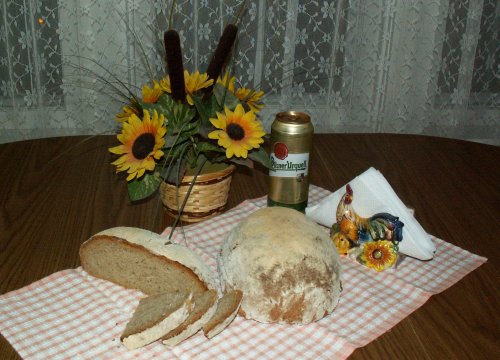
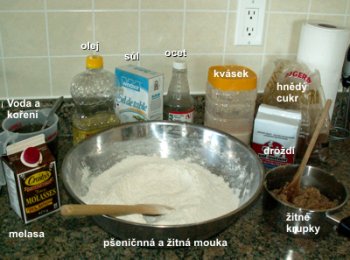
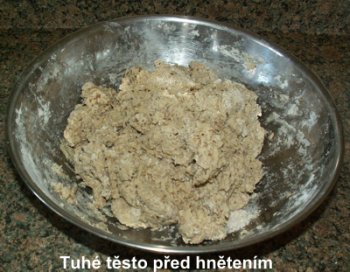
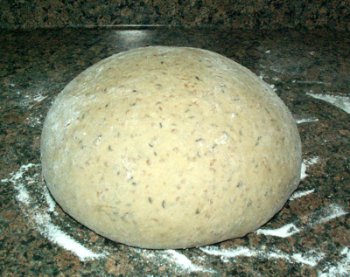
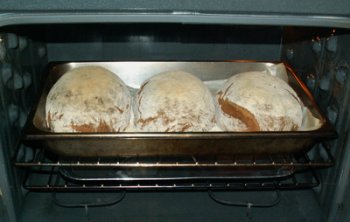
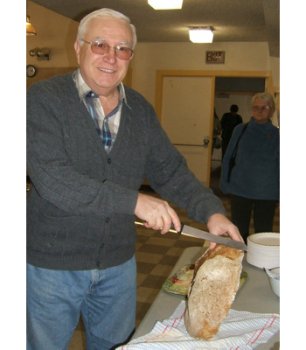
No comments:
Post a Comment
This blog is moderated. I must approve all comments (which are sent to me via e-mail automatically) in order to be visible on my blog.